Are you a fan of fresh aromatic herbs in your dishes? If so, growing herbs right at home might just become your new favorite hobby. In this blog we break down how to cultivate Oregano, which is native to the Mediterranean. In this guide we explore how to grow oregano varieties that do well in Central Florida. While these climates are very similar in temperature, they are vastly different in rainfall, which makes gardening a bit more challenging in a typically very wet Florida.
Mediterranean climates are normally quite hot, like Florida. But with the added moisture we get compared to the Mediterranean, plants native to that region require that we tweak the growing conditions to keep oregano happy.
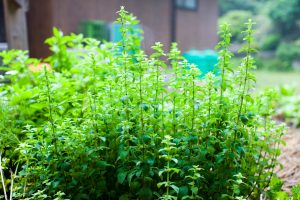
Commonly Grown Varieties
Oregano, known for its ease of cultivation and culinary versatility, adds flavor and essential nutrients including vitamins A, C, and K, as well as various B vitamins, calcium, and iron to meals.
Oregano is a hardy perennial (this herb will grow back season after season) that can be easily grown from seed or cuttings. It is also relatively easy to cultivate, making it perfect for beginners and seasoned gardeners.
- Italian Oregano (Origanum vulgare subsp. hirtum):
- Italian oregano is the most popular variety, known for its robust flavor and versatility.
- USDA Hardiness Zone: 5 to 9.
- Growing conditions: Full sun to partial shade with well-draining soil.
- Uses: This variety is perfect for garnishing dishes, adding flavor to sauces, pizzas, and grilled meats.
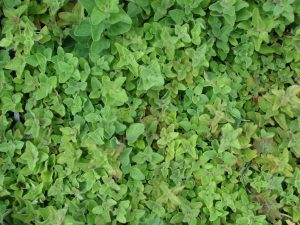
- Greek Oregano (Origanum vulgare subsp. hirtum):
- Greek oregano is another widely grown variety, prized for its strong flavor and aroma.
- USDA Hardiness Zone: 5 to 9.
- Growing conditions: Full sun to partial shade with well-draining soil.
- Uses: Greek oregano is often used in Mediterranean cuisine, including dishes like Greek salads, pasta sauces, and marinades.

- Variegated Oregano (Origanum vulgare ‘Variegata’):
- Variegated oregano features attractive green and white variegated leaves and a similar flavor to traditional oregano.
- USDA Hardiness Zone: 5 to 9.
- Growing conditions: Full sun to partial shade with well-draining soil.
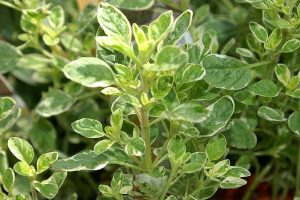
- Hot and Spicy Oregano (Origanum vulgare ‘Hot & Spicy’):
- Hot and Spicy Oregano is a unique variety. It features a distinct flavor profile with a fiery kick like hot peppers.
- USDA Hardiness Zone: 5 to 9.
- Growing conditions: Thrives in full sun with well-draining soil. It will tolerate partial shade.
- Uses: Hot and Spicy Oregano adds a bold and fiery flavor to dishes. It is a great addition to Tex-Mex, Cajun, and Caribbean dishes. It pairs well with meats, stews, sauces, and marinades, as well!
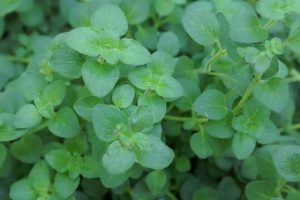
Growing Conditions
Soil Preparation
Oregano prefers slightly dry, well-draining soil with a slightly alkaline pH. Oregano thrives in a pH range of 6.0 to 8.0. In Central Florida, it is beneficial to grow oregano in raised beds to better control moisture retention and soil texture.
Oregano is drought tolerant, so it will struggle if it is sitting in standing water or grown in soil that is waterlogged. Since Florida soil tends to be sandy (in this case this is beneficial for oregano to allow the water to percolate into the soil profile), adding organic matter such as compost will improve soil structure and fertility.
If you don’t already know your soil pH and nutrient content, a great place to start is with a soil test. UF/IFAS provides Soil Testing Services that are affordable and available to the public. The results will provide valuable information about your soil’s pH, fertility levels and how to amend your soil to achieve an optimal pH range for the specific plant.
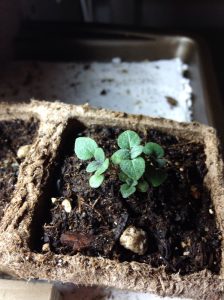
Sunlight
Oregano thrives in full sun, especially in the cooler months of Central Florida. While it enjoys sunlight, providing some afternoon shade can help protect the plant from the intense heat. Aim to provide oregano plants with at least 6-8 hours of sunlight daily.
Oregano is a winter-hardy herb, and even if it dies back, it will grow back in the spring. Still, it doesn’t hurt to protect the plant from frost, temperatures in the low 40s is too cold for oregano.
Read more about protecting your veggies from the cold here.
Fertilization
First things first, get your soil tested to determine nutrients are lacking in your soil. This information will help you select a fertilizer. When you know what nutrients are already available to your plant, you can save time and money picking them out and applying the right source of fertilizer.
You can easily and quickly (it’s very inexpensive, too!) take a soil sample using the directions and form provided by the UF/IFAS Soils Lab, where inexpensive testing is available to the public. Based on the results, choose a fertilizer that caters to the specific nutritional needs of your plants. Or, if you purchase soil, check the label to see if the soil already contains fertilizers.
Go here for directions and submission details for soil tests at the UF/IFAS Soils Lab.
Use a balanced fertilizer following the recommendations from your soil test to fertilize your plant. Apply fertilizer according to the instructions on the product label to avoid over-fertilization, which can lead to poor growth or nutrient imbalances.
Read more about fertilizers in our Fertilizer Fundamentals series:
- Fertilizer Fundamentals: How to Choose the Right One – UF/IFAS Extension Pasco County (ufl.edu)
- Fertilizer Fundamentals: How to Apply Fertilizer – UF/IFAS Extension Pasco County (ufl.edu)
- Fertilizer Fundamentals: The Best Time to Fertilize – UF/IFAS Extension Pasco County (ufl.edu)
Pests and Diseases
Pests
While oregano is relatively pest-resistant, it can be susceptible to certain insects like aphids, spider mites, and thrips. This can vary slightly for each kind of oregano. Keep an eye out for any signs of infestation, such as distorted growth or discoloration of leaves. Regularly inspect the underside of leaves, where pests often hide.
- Aphids: These small, soft-bodied insects can cluster on the undersides of oregano leaves, sucking sap and causing damage.
- Treatment: Spray the plant with a strong jet of water to dislodge them or use Neem or insecticidal soap according to label instructions.
- Spider Mites: Spider mites are tiny pests that feed on plant sap, causing stippling and webbing on leaves.
- Treatment: Use insecticidal soap or oils to control spider mite populations. If needed, remove and dispose of plants with an infestation.
- Thrips: Thrips are tiny, slender insects that feed on oregano leaves, causing silvering or bronzing of foliage.
- Treatment: Use insecticidal soap or neem oil to control thrips, ensuring thorough coverage of affected plants.
Diseases
Oregano is generally resistant to diseases, but it can occasionally suffer from fungal infections like powdery mildew or root rot, especially in humid conditions.
- Powdery Mildew: Powdery mildew appears as a white, powdery coating on oregano leaves, affecting plant health and appearance. To prevent powdery mildew, provide good air circulation around plants and avoid overhead watering.
- Treatment: Apply fungicidal sprays containing sulfur or copper if necessary, following label instructions.
- Root Rot: Root rot occurs when oregano plants are exposed to excessive moisture, leading to fungal infections and root decay. Improve soil drainage and avoid overwatering to prevent root rot.
- Treatment: Remove affected plants promptly to prevent the spread of disease.
Seasonality
Oregano is a perennial herb that thrives in Central Florida’s mild winters and warm summers. Plant oregano outdoors in the fall or early spring to take advantage of cooler temperatures and ensure successful establishment. Oregano will continue to grow throughout the year, with optimal growth during the cooler months.

Pruning Oregano for Optimal Growth
Pruning oregano helps promote bushy growth, prevent flowering, and maintain a strong flavor. Follow these steps to prune oregano effectively:
- Identify Growth Points: Oregano grows from a central stem with branches of leaves emerging from nodes along the stem. Identify the main stem and the points where leaves emerge, then use clean scissors or shears to trim stems just above a leaf node.
- Prune Regularly: Trim oregano stems regularly to encourage new growth and prevent the plant from becoming woody or leggy. Remove any dead or yellowing leaves to maintain plant health.
- Harvest Leaves: Harvest oregano leaves as needed throughout the growing season, avoiding over-harvesting to allow the plant to continue producing new growth. Use fresh oregano leaves in cooking or dry them for later use.
How to Harvest and Store Oregano
Harvest oregano leaves as needed throughout the growing season but avoid over-harvesting to allow the plant to continue producing new growth.
In mid to late summer, oregano will start to produce its cute, small white, purple, or pink flowers. For the best flavor, harvest oregano just as you see the flower buds forming. After this, the plant will have less flavor because the production of its flowers signals the end of the growing season.
Place the harvested stems in a container of water away from direct sunlight to keep them fresh for immediate use. For a longer storage period, cover the leaves (I use moist paper towels) and store them in the fridge. You can also freeze the cuttings or dry them to make your own seasoning!
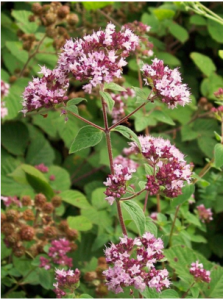
Tips for the Floridian Gardener
Florida’s subtropical climate poses both advantages and challenges when growing oregano. Our high temperatures and humidity can be challenging, but here are some additional tips for growing oregano:
- Select Heat-Tolerant Varieties: Choose oregano varieties that can thrive in hot climates, such as Italian oregano or Greek oregano. These varieties are better suited to withstand Central Florida’s high temperatures and humidity.
- Conscious Planting: In Florida, the best time to plant oregano is during the cooler months of fall and winter. Providing oregano with a bit of afternoon shade can protect it from the intense sunlight.
- Adequate air circulation: Space your plants 10-12 inches apart, this will help with air circulation and prevent extra humidity that attracts pests and diseases. Oregano’s growth is bushy and can grow up to two feet tall and up to 18 inches wide. Remember, oregano is perennial, so it will grow back season after season. Think ahead when planting!
- Mulch and Water Wisely: Apply mulch around oregano plants to retain moisture in the soil and regulate soil temperature, especially during dry spells and heatwaves. Additionally, ensure oregano receives regular watering, aiming to keep the soil consistently moist but not waterlogged.
- Monitor for Pests and Diseases: Be vigilant for signs of disease and pests. Common pests such as aphids, spider mites, and thrips can affect oregano, as well as fungal diseases like powdery mildew. Inspect the foliage regularly and take measures such as using neem oil or manual removal of insect pests. Consider selecting disease-resistant varieties where possible to minimize the risk of disease.
Conclusion
By following these tips tailored to Florida’s climate, you can cultivate oregano in your garden. Happy gardening!
Read the series:
- Spice Up Your Life: A Beginner’s Guide to Growing Marjoram
- Spice Up You Life: A Beginners Guide to Growing Sage
- Spice Up Your Life: A Beginners Guide to Growing Lavender
- Spice Up Your Life: A Beginners Guide to Growing Thyme
- Spice Up Your Life: A Beginners Guide to Growing Chives
- Spice Up Your Life: A Beginners Guide to Growing Dill
- Spice Up Your Life: A Beginners Guide to Growing Oregano
- Spice Up Your Life: A Beginners Guide to Growing Parsley
- Spice Up Your Life: A Beginners Guide to Growing Basil
Have a question?
If you have any questions about gardening in Central Florida, please contact the UF/IFAS Extension Pasco County at 352-518-0156. For more information on UF/IFAS Extension Pasco County Community Gardens, and how you can join one, visit http://sfyl.ifas.ufl.edu/pasco/. Supervising agent: Dr. Whitney Elmore
Follow us!
We have several ways to connect. Visit our Facebook, Instagram, Eventbrite, Blogs, Florida-Friendly Facebook, Website
Visit our page for more tips and tricks on maintaining a home garden!
More resources from UF/IFAS Extension Pasco County:
- UF/IFAS Extension Pasco County
- UF/IFAS Extension Pasco County Community Gardens
- Dr. Whitney Elmore’s Podcast: Rooted in Florida
More resources from UF/IFAS Extension:
 4
4
